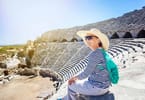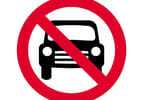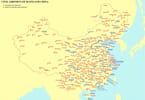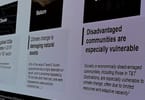Our day of trekking started early, with a 4:30 am departure from the hotel in Kigali, to make it in time for the 7:00 am briefing by park staff at the headquarters of the “Parc de Volcanoes” near Ruhengeri/Musanze district in the Rwandan highlands.
Although the distance is just over 100 km from Kigali to the park gates, the drive took 2 1/2 hours, owing to the winding roads and fog, which caused our driver guide to be extra careful.
When eventually dawn broke, a magnificent scenery emerged from the darkness and was true to the description Rwanda often gets abroad, being the “land of a thousand hills,” this number probably being largely understated.
The road, except for a few potholes, was in good shape, but I was nevertheless a little nervous, as in Rwanda, traffic follows the European and American pattern of driving on the right, whereas the rest of east Africa continues the British tradition to drive on the left, definitely something to get used to when doing a self drive. The route hugged the hill and mountain sides and wound its way up and down several valleys, only to climb higher still on the other side.
On arrival at the park headquarters assembly point, we learned that all 7 gorilla groups available for trekking that day were sold out to capacity, and with a maximum of 8 visitors to each group a day, we found another 54 fellow adventurers on site, all scrambling for information, seeking their main guide with whom they would spend the day up in the mountain and taking refreshments in the form of steaming hot brewed Rwandan tea (or coffee), before then settling down for the mandatory briefing on the dos and don’ts, the expected route, and, of course, getting to know the other members of the group.
With me was Philip Mwakio of the Standard newspaper in Kenya, and we found 6 young Americans and Canadians, either travelling the world for a while or else being attached as volunteers and interns to projects in Rwanda and the region.
We took the vehicles to reach the starting point of the trek up the mountain, all still being fit and in good spirits, and off we went, skirting the forest’s perimeter and walking by small farms before eventually entering the forest proper, having to climb over the crude perimeter wall. I felt more than a little reminded of a chapter in the Hobbit, when Bilbo and the dwarves had to enter the Mirkwood forest, and I had a keen sense of anticipation on what was to come our way. The wall boundary extends some 70 kilometers along the edge of the mountain and is made up of volcanic rocks, carefully piled upon each other without any mortar.
As the walk into the forest went on, along small animal-made tracks and through clearings with thick grass and scattered bushes, it became evident that while we were spared the rain that day – the morning clouds had long been blown away – rain over previous days left some of the bogs rather treacherous to traverse, and soon each and every one of us had stepped through the seemingly solid grass into mud holes, leaving our shoes and socks wet and our trousers caked with mud. It brought back my memories of tracking gorillas in Uganda, or doing safaris by foot in places where permitted across the east African national parks, and the unfolding scenery, with views both across the valley below and up the mountain, soon made every one forget the wet feet, until the next mud hole that was.
After trekking for about 2 hours, news reached our guide via his walkie-talkie from the park rangers further above, who keep in constant contact with the gorillas every day, that our group apparently encountered another group close up, and after some apparent chest thumping by the dominant silver backs, the two groups began to scatter away from us, deeper into the forest and higher up the mountain. This would in the end prolong our trek to almost twice the projected time frame, but this is, according to the rangers and guides, a rare occurrence – some of the visitors that day were back at base in less than four hours while we came up with the short straw.
As time went on into the third and fourth hour, spirits seemed to dampen by the minute, when suddenly two of the trackers appeared out of the thick undergrowth, giving news updates to our guide about the location of the 17 gorillas from the Kwitonda group ahead of us.
Meanwhile, we found fresh elephant dung along our route at several places, and our escorts were visibly more alert when the distinct smell of buffalo became apparent – thankfully we only saw droppings but did not encounter any of them directly as we went along.
A renewed effort made us climb yet higher, and the adrenalin rush set in when our guides told us to be still – it was then that we heard the sounds of the gorillas ahead of us, bamboo breaking, and grunting noises. We left our bag backs and walking sticks, as well as hats and caps behind, as we approached the gorillas proper. And then, lo and behold, we found ourselves face to face with the gentle giants of the volcanic mountains, awe-inspiring creatures who seemed more concerned with foraging and feeding than our presence. The rules say one has to stay 7 meters away from the animals, but what to do when suddenly one or several of them come up close, picking leaves and roots along the way, and passing you not further away than 2 feet. Stand still is the rule then, don’t move and try to be small and unthreatening. That rule worked in the several close encounters of the gorilla kind I experienced, as did others from our group.
Several of the gorilla family were, in fact, up in the bamboo trees and eventually came down to the ground to follow their peers. The dominant silver back in this group had to contend with “pretenders” to his throne, those being three more but younger silverbacks and several “black backs,” i.e. younger males and a number of females and young ones were also part of the 17. The hour permitted to be with the gorillas flew by, and after a few final pictures and intense looks at them, time was indeed up and we began our descent again.
Walking downhill, although done several times before during the approach when crossing little valleys and streamlets, proved even more challenging, and roots and vines seemed to make a habit of trapping one’s foot, while branches needed to be carefully avoided, pointing their sharp ends towards all parts of our bodies. When we finally made it to the wall – our cars just a few hundred meters away – we took stock and assessed what we had just done. Mud covered, scratched by thorns and poking branches, stung by whatever those insects were, and bitten by safari ants – at the end of our nearly 8 hours of tracking, we were told that the average was 4 to 5 hours, had it not been for two groups encountering each other and then scattering. We proudly wore our “mud medals,” which had splashed on our jackets and trousers, while the scratches on hands and forearms were considered “honor badges,” proving to all and sundry that we had indeed tracked the Rwandan highland gorillas successfully.
For anyone wishing to do this trip, a few words of advice: at the point where the tracking starts “proper,” a group of porters is available for
individual hire at a cost of about US$10 each. This is a SHOULD REALLY DO expense, as even a light rucksack will become heavier and heavier along the way in case of a prolonged trek. I took two liters of water and should have taken four at least; again the porters can carry that weight, which will rapidly reduce anyway as the water is gulped down to avoid dehydration. Sturdy walking shoes or better boots with ankle support are equally a MUST and be prepared to put them through the washing machine afterward, as the mud entered everywhere. Wear strong trousers able to withstand the constant pulling of thorn-covered vines and a waterproof jacket or anorak with long sleeves will help to avoid the worst of the scratches. A hat or cap will go a long way to keep the scalp intact, as thorny vines seem to make it their day’s work to attack every available body part coming near them.
And finally, remain committed to the tracking – even when the wish to find a helipad or the cars around the next corner becomes overwhelming as the body begins to show strains and tells you enough is enough. When you finally encounter the gorillas, the reward is just out of this world and not to be missed. There is time to rest when returning to base at the end of the day. Ours was admittedly a very long one, but worth every minute of it. Every member of our group was given a certificate by Rwanda Tourism Board offices (ORTPN) to proclaim which of the habituated gorilla groups we had visited, and after a last group photograph, we then parted company, having shared one of the most intense wildlife experiences east Africa, and especially Rwanda, has to offer.
The cost of the one day trip, which permits one hour with the gorillas when they have been found, is US$500 per person, per trekking – incidentally the same in Uganda and Congo DR – plus, of course, the cost of transport from Kigali to Ruhengeri (public transport is available), accommodation suiting one’s budget ranging from basic but clean to very luxurious hotels, lodges and safari camps, the daily meals and drinks (take lots of water to avoid dehydration), and tips/gratuities as and where appropriate – the guides, trackers, escorts, and porters for sure deserve one – and other items of personal nature. Each member of our group, some of them traveling students, and also other tourists polled in the evening, commented that the money spent was absolutely worth the experience and they would do it again, though possibly not the next day considering the sore muscles and aches.
An international multi-socket adapter will be helpful to recharge phones, cameras, and netbooks, as the electrical sockets in Rwanda are not compatible with the widely used three pin that is common across the rest of eastern Africa, and adapters are rarely available on site. Interesting enough, mobile phones do work, even up the mountain, but it is a MUST to either have them on silent or switched off once inside the national park.
My trip was made possible courtesy of RwandAir, which provided the ticket to fly from Entebbe to Kigali and the Rwanda Development Board/Office for Tourism and National Parks. My personal thanks here go to Michael Otieno, marketing manager, and to Flora Butamire, the CEO’s PA – both of RwandAir, and to Rosette Rugamba and Annette Mbabazi of the RDB/ORTPN. RwandAir flies to all the regional centers and has daily flights from Entebbe, Nairobi, and other airports in east Africa to Kigali. They use a CRJ200 and a Bombardier Dash 8, depending on the route and flight loads.
While in Ruhengeri, I stayed at the newly-opened Gorilla Hotel – a befitting name, of course, found on plenty of businesses in the Musanze district, which provided all creature comforts needed after a long day up in the mountains. There are several lodging facilities near the park and around Ruhengeri aimed at the tourist market with a variety of budget ranges, and the guide books and web guides give plenty of information to intending visitors. See www.rwandatourism.com for more details on the tourism attractions of the country, which go way beyond gorilla trekking.
WHAT TO TAKE AWAY FROM THIS ARTICLE:
- On arrival at the park headquarters assembly point, we learned that all 7 gorilla groups available for trekking that day were sold out to capacity, and with a maximum of 8 visitors to each group a day, we found another 54 fellow adventurers on site, all scrambling for information, seeking their main guide with whom they would spend the day up in the mountain and taking refreshments in the form of steaming hot brewed Rwandan tea (or coffee), before then settling down for the mandatory briefing on the dos and don'ts, the expected route, and, of course, getting to know the other members of the group.
- The road, except for a few potholes, was in good shape, but I was nevertheless a little nervous, as in Rwanda, traffic follows the European and American pattern of driving on the right, whereas the rest of east Africa continues the British tradition to drive on the left, definitely something to get used to when doing a self drive.
- As the walk into the forest went on, along small animal-made tracks and through clearings with thick grass and scattered bushes, it became evident that while we were spared the rain that day – the morning clouds had long been blown away – rain over previous days left some of the bogs rather treacherous to traverse, and soon each and every one of us had stepped through the seemingly solid grass into mud holes, leaving our shoes and socks wet and our trousers caked with mud.






















